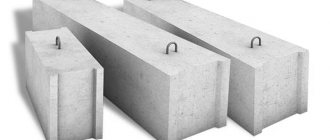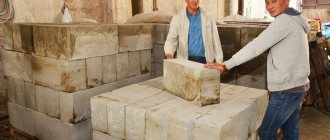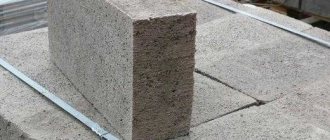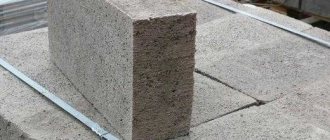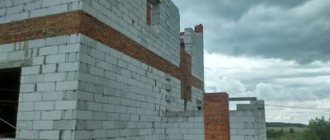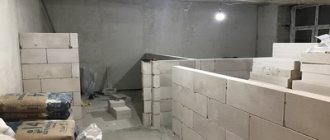Blocks made of sawdust and cement are a lightweight and durable modern building material, part of the group of concrete products with a reduced specific gravity. Sawdust concrete is made from chips of different types of wood and cement mortar, which acts as a binder. The material has unique properties, which makes it popular for use in a wide variety of construction areas.
The main characteristics of sawdust concrete are high thermal properties, environmental friendliness, increased strength and resistance to fire, good vapor permeability, preservation of properties under sudden temperature changes, high minus and plus. It is also important that the cost of the blocks is relatively low and, if desired, you can make them yourself.
Types of sawdust blocks by specific gravity:
- Thermal insulation – weight within 0.4-0.8 t/m3
- Structural – weight in the range of 0.8-1.2 t/m3
Before using blocks made of shavings and cement in any work, it is necessary to carefully study their technical characteristics and perform calculations. If you want to produce the material yourself, you must become familiar with the technology and rules for choosing raw materials.
Blocks based on shavings and cement - area of application
The material is used in a variety of fields, but mainly in the construction of low-rise buildings. Most often, sawdust concrete is used to build dachas, garages, internal partitions in private houses, town houses, cellars, cottages, and domestic buildings.
Sawdust concrete is also popular for carrying out work on insulating basements, capital walls of buildings, and creating an insulating layer. Blocks can be useful in the construction of various types of fences. They are rarely used where there are heavy loads - the construction of a foundation, load-bearing walls, floors, etc.
Usually they use the maximum thermal insulation characteristics and implement structural solutions indoors, in creating unloaded structures, etc.
Where there is high humidity, it is advisable to make slabs or blocks with an additional layer of insulation, as they will absorb moisture. With proper protection and consideration of all properties, sawdust concrete made from wood chips is able to retain its geometric shape, as well as mechanical and operational properties, for a long time.
Masonry technology
When the blocks are ready, you need to proceed directly to laying them. Let's look at the work process step by step, and start with the list of necessary tools and materials.
Required materials and tools
What do you think is better to choose, specialized glue or cement mortar? Let's analyze.
- As we found out, sawdust concrete has a low thermal conductivity coefficient. The glue is characterized by the same quality. But cement mortar is quite the opposite.
- Moreover, the thickness of the layer when laying using homemade cement mortar will be significantly higher, which will increase the number of cold bridges, and, as a result, reduce the thermal efficiency of the wall.
- Is the solution cheaper? In essence, this is true. However, if everything is carefully calculated, the costs can vary greatly.
- The room will become colder, and this will require more intensive insulation. And if specialists are hired, their services will be more expensive, since mixing cement mortar requires a lot of labor and time.
- We conclude: glue is definitely better and more practical.
The following tools are required:
- Building level;
Construction level
- Thread or cord;
Construction thread
- Rubber hammer;
Kiyanka
- Tool for applying the solution;
Bucket scraper
- Mesh for reinforcement;
- Hacksaw;
Hacksaw suitable for cutting sawdust concrete
- Container for mixing glue;
Construction bucket
- Concrete mixer in case a solution will be used. It is necessary for its kneading;
Concrete mixer
- Mixer, drill;
Drill mixer
- Square.
Square
Laying process
Laying sawdust concrete is similar to the work process during the construction of buildings made from other lightweight concretes.
The order of work is as follows:
- The first products are laid in the corners of the future building.
- Experts recommend installing the first row using a cement-based mortar.
- A construction cord is stretched between the products, which will help you better navigate in terms of evenness.
- If it becomes obvious that the block needs to be cut, you can use a simple hacksaw for this, since sawdust concrete can easily be processed in any way.
- When laying row after row, one should not forget about bandaging; one should not allow the vertical seams to coincide.
- To improve the strength characteristics of a structure, it is necessary to carry out reinforcement.
- During work, be sure to check the evenness of the masonry using a level and correct it in time, since after the mortar has set, it will no longer be possible to disassemble the laid area.
In this way, row after row is laid until the required masonry height is reached.
Finished structure made of sawdust concrete
Advantages and disadvantages
Before you start making blocks from sawdust and cement with your own hands, you need to thoroughly study the properties of the material, the pros and cons. Taking into account the specificity of its composition, sawdust concrete is not suitable for all jobs and operating conditions, but if all requirements are met, it can be a really good choice.
The main advantages of sawdust concrete:
- High level of thermal insulation - houses keep cool in summer, warm in winter, like a thermos.
- Environmentally friendly and safe for people - the absence of toxins and harmful emissions guarantees a positive microclimate in the home and the absence of allergies.
- Strength – good structural indicators; some types of sawdust concrete can be used for the construction of load-bearing structures (but not higher than 3 floors).
- Resistance to fire - due to the introduction of synthetic additives into the composition, making the material capable of not burning for 2 hours at a temperature of +1200 degrees.
- Excellent vapor permeability - due to the porous structure, sawdust concrete allows air to pass through and does not retain moisture.
- Resistance to sudden temperature changes - not afraid of freezing/thawing, does not deform under external influences.
- Affordable cost - a little more expensive than aerated concrete, but if you make it yourself, the price is even lower.
- Good sound insulation performance - due to the porosity of the material, it works in both directions (outside/inside).
- Simple work - easy installation due to minimal weight and ideal geometric parameters, cutting, drilling while maintaining the integrity of the structure and shape.
- Use of recycled materials - all types of cement-bonded blocks and slabs are created on the basis of wood chips or shavings, which are waste from wood processing. You can buy sawdust at a low price.
- Long service life - if optimal conditions are provided, blocks made of sawdust and cement last for decades.
- Light weight - which facilitates installation and reduces the overall pressure of the structure on the base.
Among the disadvantages of the material, it is worth noting the following: low level of moisture resistance and the need for protection, limited choice of raw materials in terms of wood species, long duration of production stages (after the material is poured into molds, it must harden and dry for at least 3 months before starting work ).
Advantages and disadvantages
The blocks have the following advantageous characteristics:
- High thermal insulation;
- Environmental friendliness;
- Availability;
- Vapor permeability;
- Fire resistance;
- Strength;
- Resistance to cold and frost.
A special advantage will be its weight, since it will be only 50 tons with an area of 250 m2. Thanks to this quality of the material, you can significantly reduce the cost of building a foundation. In addition, the low cost of sawdust concrete blocks themselves will also allow you to save money.
The main disadvantage of a sawdust concrete block is its ability to absorb moisture. This is very bad for the material, but it is possible to prevent the absorption of liquid if you paint them externally with some compounds and paints, and carry out high-quality waterproofing inside.
Sawdust concrete blocks: characteristics
Sawdust concrete requires certain properties and requirements for use in construction. So, to prevent moisture from entering, the base of the house is usually made of concrete or brick with a height of at least 50 centimeters from the blind area. Also, the projection of cornices beyond the boundaries of the facade walls is made at least 50 centimeters with the installation of a system for draining melt and storm water.
The thickness of the seams between the blocks is about 10-15 millimeters; often the blocks are used only for laying the insulating inner layer.
If cement-bonded particle blocks (slabs) are used to create window/door lintels, they must be reinforced. As for the remaining requirements, they are all determined by the characteristics of the material.
Block composition
Main components of sawdust concrete:
- Sand – increases strength, but reduces thermal insulation properties (therefore it is important to choose the optimal proportion)
- Portland cement - minimum grade M400
- Wooden shavings (chips) – enhances sound/heat insulation, dried before use
- Special additives - to ensure fire resistance, impregnation against rodents, etc.
Components
In the production of sawdust concrete, waste from a variety of wood species can be used: fir, pine, poplar, spruce, beech, birch, ash, hornbeam, oak, larch. But the best choice is considered to be coniferous wood chips, since they have a higher concentration of resin that protects against rot.
Pine is characterized by accelerated hardening - blocks can be used in construction within 40 days after pouring into molds. Oak chips and larch extend the period of strength development - they require settling for at least 100 days.
In order to increase strength, resistance to fire and reduce the ability to absorb moisture, wood components are prepared in a special way: soaked in lime milk, dried (forced/natural), soaked in liquid glass mixed with water (1 part glass and 7 parts water). To ensure the homogeneity of the material, the chips are passed through a sieve with cells of 10-20 millimeters.
Proportions
The ratio of materials in the composition directly affects the density and other characteristics. Sawdust concrete comes in different classes, which determine the properties and proportions. Thus, M5/10 classes are used for insulation and reconstruction work, M15/20 - for the construction of internal/external walls.
Proportions of materials for 1 m3 of sawdust concrete:
- Grade 5 (density about 500 kg/m3) – 50 kg of cement and sand, 200 kg of lime and sawdust
- 10 grade (650 kg/m3) – 100 kg of cement, 200 kg of sand, 150 kg of lime and 200 kg of sawdust
- 15 grade (800 kg/m3) – 150 kg of cement, 350 kg of sand, 100 kg of lime and 200 kg of sawdust
- 20 grade (density 950 kg/m3) – 200 kg of cement, 500 kg of sand, 50 kg of lime, 200 kg of sawdust
Mixing components
The mixing process is as follows: measure all the materials, mix dry sand and cement, add lime and sawdust, mix thoroughly again, pour in water in portions, achieving the desired consistency of the solution.
First, it is advisable to make a test batch, check the mixture for elasticity: if the lump crumbles, you need to add water, if the water drains, reduce the volume. A properly mixed solution hardens within an hour.
Sawdust size
This parameter has little effect on the strength of the blocks; the homogeneity of the material is more important here, rather than the size. Therefore, sawdust is chosen so that all components are of the same size and make it possible to prepare a homogeneous mixture.
Suitable shavings from a sawmill – it doesn’t matter whether it’s a disk saw or a belt sawmill. But you should not take sawdust from calibrating or rounding machines, since they are heterogeneous in structure.
Description of material
Sawdust concrete is a material that can be classified as lightweight. To create it, sawdust, cement and sand are used directly. It was developed in the 60s, but became widely used only in the 90s.
Due to its high sanitary and hygienic properties, it can be used for the construction of absolutely any buildings and institutions, including those intended for children.
The blocks can be subjected to absolutely any mechanical treatment, since they practically do not crack or chip. Very often they are confused with wood concrete blocks. These two building materials differ in the use of different aggregates in them.
As for wood concrete, crushed wood chips are used for its production, which are obtained by grinding waste wood, as well as crushing reeds and cotton stalks, and for the production of sawdust concrete only sawdust is used.
Types of wood-cement materials
The variety of wood-cement materials is not very large. The blocks differ in the type of chips and the proportions of materials in the composition, structure, and type of binder. The most popular types of cement particle blocks: fiberboard and wood concrete, cement particle board, sawdust concrete and xylolite.
In terms of strength, slabs come in different grades from M5 and classes from B0.35, density - an indicator in the range from 400 to 800 kg/m3.
Arbolit
It is made from a large volume of wood chips, sand, Portland cement, water and chemical additives. Usually, wood processing waste from coniferous and deciduous trees is used, less often - straw, hemp/flax kernels, crushed cotton stalks, etc.
Wood concrete can be used for thermal insulation and construction purposes. The first type has more chips, the second is more durable. Where it is used: floor slabs, bricks for forcing internal/external walls, coverings and ceilings, large wall panels.
Fibrolite
Typically supplied in cement and chip board format. For production, wood chips 35 centimeters long or more and up to 10 centimeters wide are used, which are ground into wool.
After grinding, the raw material is mineralized with potassium chloride, moistened with water, mixed with concrete, and pressed under a pressure of 0.4 MPa into slabs. Next, the products undergo heat treatment and drying. Fibrolite can also be used for insulating, structural and thermal insulating purposes.
Main characteristics of fiberboard:
- Fire safety – lack of ability to burn with an open flame
- Rough surface – provides good adhesion to other materials
- Thermal insulation – thermal conductivity is in the region of 0.08-0.1 W/m2
- Moisture absorption – 35-45%
- Ease of processing - the material can be sawed, drilled, dowels driven into it, etc. without the risk of splitting or deforming
- Susceptibility to mold and mildew when exposed to humidity above 35%
Sawdust concrete
This material is similar to wood concrete, but is not so demanding on the type and parameters of wood chips. It consists of cement, sand, water, sawdust of various fractions, clay and lime may be included. The proportion of sand here may be greater than in wood concrete, therefore the strength is higher at the same density.
Sawdust concrete provides greater weight of the supporting structure with the same strength class. In terms of thermal insulation characteristics, the material is also inferior to wood concrete.
The main advantage of sawdust concrete is its low cost in the absence of special operating conditions, which makes its use in construction more profitable.
Cement particle boards
The material is created from a wood-shaving mixture mixed with cement, water and mineral additives, which is then dosed, poured into molds, pressed and treated with high temperature. The main advantages of the slabs: non-flammability, resistance to frost, biological inertness.
Plates are often used in prefabricated structures, in the implementation of interior and facade work. The slabs are distinguished by a high level of moisture resistance; the only disadvantages can be distinguished by their rather large weight and low elasticity. When bending, the slabs break (at the same time they demonstrate good resistance to longitudinal deformations), therefore they are often used to strengthen the frame.
Xylolite
Sand material made from magnesium binder and wood waste (flour and sawdust). Fine mineral substances are also added to the composition: marble flour, talc, alkaline pigments, etc. Production is carried out using a temperature of +90 degrees and a pressure of around 10 MPa, which makes the material especially durable after hardening. Typically, slabs of this type are used to create floors.
Characteristic features of xylolite:
- Non-flammability
- High level of compressive strength (5-50 MPa, depending on the type of material)
- Resistance to shock loads, no risk of crushing or chipping
- Excellent heat/sound insulation characteristics
- Resistance to moisture, frost
Specifications
The density of sawdust concrete blocks can be adjusted independently by increasing the proportion of sawdust and sand in its composition. The higher the density of the material, the higher the material's thermal and sound insulation properties. In this case, its strength will also increase.
Several groups of sawdust concrete blocks can be distinguished, which are divided from high technical characteristics to lower ones:
- M5. The most optimal option for the construction of foundations and walls of buildings, as it has greater density.
- M10. Blocks with similar strength are good for reconstructing walls and basements.
- M15 and M20 are equally well suited for the construction of internal walls and partitions, as well as for cladding.
The main indicators of the characteristics of sawdust concrete blocks are reflected in the table:
| Average density, kg/m3 | 500-850 |
| Compressive strength, MPa | 0,5-3,5 |
| Thermal conductivity, W/(m2·?С) | 0,08-0,17 |
| Bending strength, MPa | 0,7-1 |
| Modulus of elasticity, MPa | 250-2300 |
| Frost resistance, cycle | 25-50 |
| Water absorption,% | 40-85 |
| Shrinkage, % | 0,4-0,5 |
| Biostability | Group V |
| Fire resistance | 0.75-1.5h |
| Sound absorption, 126-2000Hz | 0,17-0,6 |
Making blocks yourself
When starting to create blocks from sawdust and cement with your own hands, you need to thoroughly study the entire process and take into account the nuances.
How to create blocks yourself:
- Prepare all the tools and devices for working with the mixture - concrete mixer, hammer crusher, chipping machine, vibropressing machine, vibrating machine, etc.
- Prepare raw materials - buy at least M400 cement at a hardware store, order clean sand, lime (clay can be used), find a lot of sawdust at the factory (preferably dry, if the region is humid - you also need to stock up on mineralizers for processing sawdust, which can be liquid glass or milk of lime).
- Thorough chopping of wood by loading it into a chipper and then into a hammer crusher (to obtain the same fraction).
- Carefully sifting the wood chips to separate debris, soil, bark, etc.
- Impregnation of wood chips - soaking in a mixture of liquid glass and water in a ratio of 1:7. To speed up the process of mineralization and hardening of the material, you can add a little calcium chloride.
- Treatment with slaked lime – disinfection against pests.
- Mixing - to obtain a standard mixture, take 1 ton of Portland cement, 250 kg of lime and 2.5 tons of sand. The volume of chips is determined separately, based on the required characteristics and type of blocks. Everything is mixed in a concrete mixer.
- Pouring the mixture into molds and installing it on a vibrocompression machine.
- Drying - stretching the film over a container with molds, keeping it indoors for 12 days at a temperature of +15 degrees and above (in the cold, hydration will take place much more slowly). The material can be checked periodically - if it is dry, moisten it with water.
Sawdust and cement blocks are an excellent choice for performing many jobs in the field of renovation and construction of low-rise buildings. With the right choice of high-quality material and compliance with the work technology, creating optimal conditions, sawdust concrete will ensure the reliability, strength and durability of the structure.
Building blocks
Block is a piece building material with a wide range of applications.
It is produced by molding on the basis of both cement and cementless (for example, based on gypsum, lime or magnesia) concrete*. Building blocks (cinder blocks, expanded clay blocks, arbolite - sawdust concrete blocks, sand blocks) are a common and very popular building material. It is usually used for the construction and insulation of cottages, garages, garden and country houses, residential buildings, and outbuildings. In industry it is used in the construction of hangars, warehouses and production facilities.
The term “Cinder Blocks” is widely used among people. This is what all building wall blocks without exception are often called. In fact, cinder blocks can be called building blocks (wall blocks) made from concrete made with the following aggregates: slag, ash, coal combustion waste (or other materials). In addition, during the actual production process, any of the most available materials in your region can be added to the cinder block composition - this can be crushed stone screening (stone, granite), brick waste, gravel, sand.
If a block is made of a cement-sand mixture, then it is usually called sand block .
If expanded clay or sawdust (chips, shavings) are used as the main filler in addition to sand, then such blocks can be called expanded clay blocks or wood concrete (sawdust concrete) blocks , respectively.
We draw your attention to the fact that the overall dimensions of the blocks of the entire range produced on our VIBROMASTER vibrating machines were not chosen by chance. These dimensions make it possible to use blocks in combined masonry with brick, that is, to carry out interlocking masonry, with brick masonry going into block masonry or vice versa.
* — Concrete (from the French beton) is an artificial stone obtained as a result of the hardening of a rationally selected and compacted mixture of a binder (the most common is cement or others), aggregates and water.
In some cases, concrete may contain special additives.
Fillers (crushed stone, expanded clay, sand, etc.) form a spatial skeleton, like a frame for the future artificial stone - concrete. A binder (cement or other) binds (to put it simply, glues) the elements of the filler into a single whole. In this case, water acts as an activator of the binder. As a humorous illustration of what concrete is, we can cite the following - a very childish example - papier-mâché. For those who don’t know, this is a toy glued together from small pieces of paper using paste. The paste is made from starch and water. We get real concrete (!), where starch is the binder, and pieces of paper are the filler for this kind of children's concrete.
What is written in GOST about sawdust concrete
The material complies with all modern sanitary and hygienic requirements. Non-flammable and suitable for any construction work. Its fire-resistant properties are higher than those of polystyrene concrete.
When constructing one-story buildings, you can use foam concrete blocks with a strength of 16-19 kilograms per square centimeter - M25 concrete has the same properties. For the construction of houses with 2 or more floors, a material with a strength of 49 to 99 kilograms per square centimeter (concrete M50-100) is used.
To produce sawdust concrete with high strength, it is necessary to use M500 concrete, as well as special modifying additives.
Sawdust concrete blocks
Many people want to learn more about making sawdust concrete blocks with their own hands. The main problem is that there is very little information on this issue, although many enthusiasts have been constructing buildings and country houses from similar blocks for quite a long time, because the components required to produce the product are not in short supply. In this article we will look at the nuances and subtleties of making sawdust concrete with our own hands, as well as the types, characteristics and proportions of sawdust concrete.
Sawdust concrete is a product made from sand, sawdust, cement and lime mixed in different proportions. This building product is classified as a type of lightweight construction material. Blocks were invented in the second half of the twentieth century, but gained popularity only at the end of the century.
Since sawdust concrete and lime blocks have a large number of sanitary and hygienic advantages, they can be used for the construction of completely different types of structures, for example for children or medical purposes.
A wide variety of mechanical finishing can be done on the blocks, because they are practically indeformable. This material is often confused with wood concrete blocks. However, the manufacture of these materials occurs from different components.
What characteristics do they have (pros and cons)?
The main properties of sawdust concrete that are important to the consumer:
The main disadvantage of this product is that it absorbs moisture. However, this nuance can be solved, because the facade can be coated with water-repellent solutions. But the inside of sawdust concrete is covered with special waterproofing mixtures. Another disadvantage is that not all sawdust is suitable as the main component.
Table of proportions of sawdust concrete components
| Brand | The ratio of components in the indicated order (cement, lime, sand, dry sawdust) |
| 5 | 1:1:0:2 |
| 10 | 1:2:8 |
| 15 | 1:1,2:5 |
| 25 | 1:1:1,2:4 |
During construction, you need to remember: the lower the sawdust content, the stronger the product. At the same time, heat and noise insulation properties are reduced. The weight of the concrete in question is lower than many building materials, which reduces the load on the foundation. There is also no need to use special equipment.
Additional properties of sawdust concrete
The good thermal insulation qualities of sawdust concrete have become the reason for its use for cladding load-bearing structures of houses. In this case, it is used as insulation. To insulate the ceiling or ceiling, thin blocks 100 mm thick are used. They are either poured into specially prepared molds or cut from standard blocks. For wall cladding, stones of standard sizes or with reduced parameters are used. Thermal insulating masonry mortars are used for installation.
Forms, laying, drying
There are no clear instructions in building regulations about the standard sizes of sawdust concrete blocks. Therefore, their dimensions can be chosen arbitrarily, focusing on the thickness of the walls, the size of window openings and the distance from the corners of the masonry.
Most often, ready-made metal molds for cinder blocks measuring 40x20x20 cm are used for pouring or they are assembled independently from boards.
The geometry of the finished block depends on the quality of the form.
The picture shows a convenient collapsible structure made of boards. It is designed for 9 blocks. It has no bottom. It is replaced by a steel sheet on which the mold is placed for pouring. After drying is completed, the mold is disassembled by unscrewing the tightening screws and the finished blocks are removed.
Homemade mold for sawdust concrete blocks: a - general view; b – board joining unit 1 – side frame with handles, 2 – partition, 3 – tightening screw, 4 – sheet metal lining.
To reduce the weight of the blocks and speed up drying, voids are made in them. The easiest way to do this is to use glass half-liter bottles, inserting them into the raw mixture and removing them after it sets. Below we see one of the options for this design.
Formation of voids in blocks
The inside of the boards should be lined with plastic or sheet metal. This is necessary so that the wood does not draw water from the solution and does not dry it out.
When placing the mixture into the mold, it must be thoroughly compacted to eliminate air voids. The air temperature during drying should not be lower than +15 C.
After keeping the mixture for 3 days, it is checked for readiness by running a nail along the sawdust concrete. If it does not leave deep scratches on the surface of the blocks, then they can be removed from the molds and left to dry under a canopy for at least another 3 days.
Our information: after 3 days of aging in the mold, the block gains 30% of its brand strength. Over 3-4 days of subsequent drying, its strength increases to 70%.
Final quality control - dropping the block from a height of 1 meter. High-quality material should not collapse.
Useful tips for organizing drying:
- A draft speeds up the drying process;
- When laying out blocks for drying, ventilation gaps of at least 10 cm must be left between them;
- If there is no canopy, the material must be covered with a film that protects it from rain.
The final drying operation is stacking the blocks in columns. They are formed by laying successively two blocks lengthwise and two blocks across them on top (ligation of sutures).
The material should remain in this form for 1 month. During this time it will reach 90% of its strength. The blocks will take 3 months to be fully ready.
Tips for making quality blocks:
- Sawdust must be sifted twice before loading into a concrete mixer: first through a mesh with a mesh of 1 cm, then through a sieve with mesh of 5 mm.
- For work, it is recommended to use cement grade no lower than 400.
- It is better to compact the mixture using a mechanized method (surface vibrator).
Laying sawdust concrete is completely similar to working with wood concrete and aerated concrete blocks. To strengthen the walls, use a steel mesh, laying it every 3 rows.

